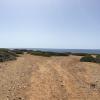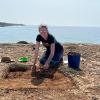Ancient Seafaring Explorers of Cyprus Project
The discovery of new hunter-gatherer and early farming occupations on the Mediterranean Island of Cyprus is dramatically changing our understanding of the timing and nature of the first occupants of the island. Archaeological evidence suggests that Epipalaeolithic hunters-gatherers in Cyprus arrived by at least 13,000 years ago. These early islanders remained deeply connected to their mainland (Levantine and/or Aegean) counterparts and, like them, experimented with plant and animal management.









